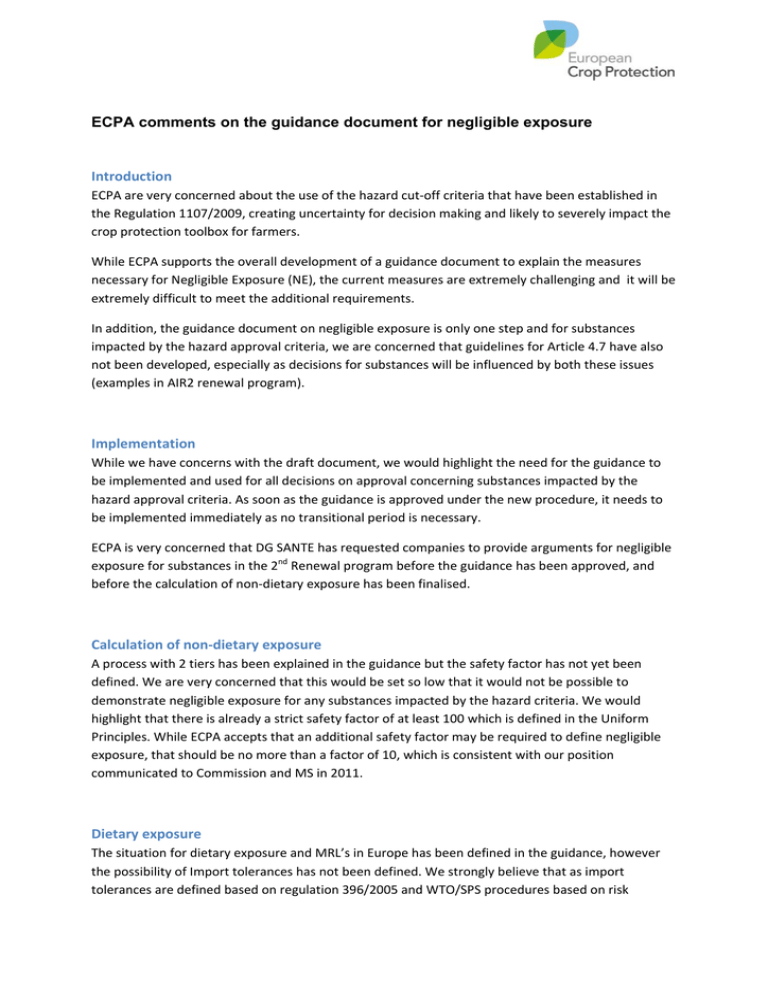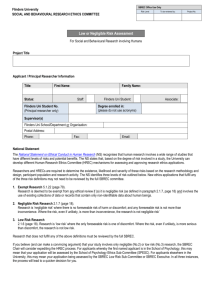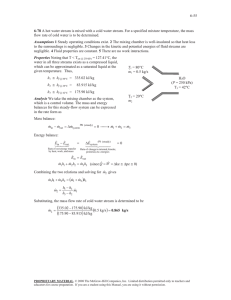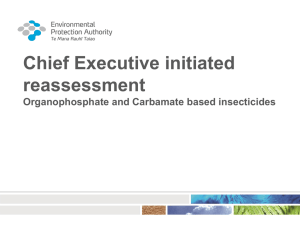ECPA comments on the guidance document for negligible exposure
advertisement

ECPA comments on the guidance document for negligible exposure Introduction ECPA are very concerned about the use of the hazard cut‐off criteria that have been established in the Regulation 1107/2009, creating uncertainty for decision making and likely to severely impact the crop protection toolbox for farmers. While ECPA supports the overall development of a guidance document to explain the measures necessary for Negligible Exposure (NE), the current measures are extremely challenging and it will be extremely difficult to meet the additional requirements. In addition, the guidance document on negligible exposure is only one step and for substances impacted by the hazard approval criteria, we are concerned that guidelines for Article 4.7 have also not been developed, especially as decisions for substances will be influenced by both these issues (examples in AIR2 renewal program). Implementation While we have concerns with the draft document, we would highlight the need for the guidance to be implemented and used for all decisions on approval concerning substances impacted by the hazard approval criteria. As soon as the guidance is approved under the new procedure, it needs to be implemented immediately as no transitional period is necessary. ECPA is very concerned that DG SANTE has requested companies to provide arguments for negligible exposure for substances in the 2nd Renewal program before the guidance has been approved, and before the calculation of non‐dietary exposure has been finalised. Calculation of non‐dietary exposure A process with 2 tiers has been explained in the guidance but the safety factor has not yet been defined. We are very concerned that this would be set so low that it would not be possible to demonstrate negligible exposure for any substances impacted by the hazard criteria. We would highlight that there is already a strict safety factor of at least 100 which is defined in the Uniform Principles. While ECPA accepts that an additional safety factor may be required to define negligible exposure, that should be no more than a factor of 10, which is consistent with our position communicated to Commission and MS in 2011. Dietary exposure The situation for dietary exposure and MRL’s in Europe has been defined in the guidance, however the possibility of Import tolerances has not been defined. We strongly believe that as import tolerances are defined based on regulation 396/2005 and WTO/SPS procedures based on risk assessment and not hazard assessment, that Import tolerances will be maintained for substance impacted by the hazard criteria, otherwise European consumers will be deprived of solutions for safe food, especially for crops which are not grown on EU soil. Environmental exposure ECPA is dissatisfied that no specific measures have been developed in this guidance for negligible environmental exposure. This is a requirement in Regulation 1107/2009, although the definition of NE is even less well defined for environmental exposure compared to human exposure. We understand that some substances currently passing through the renewal process will need this guidance as part of decision making. The detailed ECPA view on this issue is included as an annex to this document. List of professional use risk mitigation measures (Additional suggestions) While we appreciate that the annex to the draft technical guidance is a non‐exhaustive list, we would suggest two additional examples of professional use risk mitigation measures which contribute to reduce exposure of humans to PPPs, as follows: For workers (Page 16), we would suggest adding: ‐ Drip irrigation systems that deliver the product directly to the soil (while worker contact is with the foliage) For bystanders and residents (Page 16), we would suggest adding: ‐ Novel coarse‐droplet generating techniques that are intended to end up as coarse droplets to the leaves explicitly avoiding the fruits. (Note: in such situations, spray drift for drivers, workers and residents is reduced to negligible levels). ECPA 24th July 2015 PP/15/EJ/25228 ANNEX: Defining “negligible exposure” within the context of Regulation 1107/2009 1. Scope, purpose and content This position paper is the European Crop Protection Association’s (ECPA) proposal for the interpretation, guidance and implementation of the “negligible exposure” provision in Annex II point 3.8.2 and 3.8.3 of the Regulation 1107/2009 to non‐target organisms (ecotoxicology) in the context of the risk managing decision making for the approval of active substances and the authorisation of plant protection products. 2. Background and Introduction Regulation EC 1107/2009 concerning the placing of plant protection products on the market entered into force in December 2009. It replaced Directive 91/414/EEC on 14th June 2011 and applied from that date. Annex II of the EU Regulation 1107/2009 sets out the procedure and criteria for the approval of active substances, safener and synergists. It is based on two principles, firstly of hazard based “cut‐off” criteria, and followed by risk assessment. There are some derogations for active substances which fail the hazard based “cut‐off” criteria and one of these derogations is negligible exposure to non‐target organisms. It is a principle in the area of ecotoxicology that effects refer to the population level rather than an individual and that this is accepted as being different from human health assessments. Therefore, for environmental health assessments the protection goal should be set at population level in accordance with EFSA (EFSA, 20101) and the WHO definition of what constitutes an endocrine disruptor (ED). This would imply that the risk assessment would need to cover a temporal and geographical scale in accordance with a population level protection goal. In section 3.8 Ecotoxicology it sets out guidance for the approval based upon risk assessment (see section 3.8.1). In addition, it mentions two special criteria that must be met - not to have endocrine disrupting properties - no unacceptable acute or chronic effects on colony survival and development, taking into account effects on honeybee larvae and honeybee behaviour unless there is negligible exposure. (Direct quotation of regulation from page L 309/44) “3.8 Ecotoxicology 3.8.1. An active substance, safener or synergist shall only be approved if the risk assessment demonstrates risks to be acceptable in accordance with the criteria laid down in the uniform principles for evaluation and authorisation of plant protection products referred to in Article 29(6) under realistic proposed conditions of use of a plant protection product containing the active substance, safener or synergist. The assessment must take into account the severity of effects, the uncertainty of the data, and the number of organism groups which the active substance, safener or synergist is expected to affect adversely by the intended use. 3.8.2 An active substance, safener or synergist shall only be approved if, on the basis of the assessment of Community or internationally agreed test guidelines, it is not considered to have endocrine disrupting properties that may cause adverse effects on non‐target organisms unless the exposure 1 EFSA 2010. Scientific Opinion on the development of specific protection goal options for environmental risk assessment of pesticides, in particular in relation to the revision of the Guidance Documents on Aquatic and Terrestrial Ecotoxicology (SANCO/3268/2001 and SANCO/10329/2002). EFSA Journal 2010;8(10):1821. [55 pp.] doi:10.2903/j.efsa.2010.1821. Available online: www.efsa.europa.eu/efsajournal.htm of non‐target organisms to that active substance in a plant protection product under realistic proposed conditions of use is negligible. 3.8.3 An active substance, safener or synergist shall be approved only if it is established following an appropriate risk assessment on the basis of Community or internationally agreed test guidelines, that the use under the proposed conditions of use of plant protection products containing this active substance, safener or synergist: - will result in a negligible exposure of honeybees, or - has no unacceptable acute or chronic effects on colony survival and development, taking into account effects on honeybee larvae and honeybee behaviour.” Considering this background, a technical definition of "negligible exposure" is necessary, which should take into account several factors, for instance the populations to be considered, the potential routes of exposure including the mixtures (formulations) used, and the risk thresholds set for the decision making. The question therefore arises – how to define negligible exposure for ecotoxicology? 3. ECPA Proposal for “Negligible exposure” to non‐target organisms In this paper a proposal to define negligible exposure to non‐target organisms is given, and in addition the concept of negligible effects and negligible risk is developed. In the case of compounds that have endocrine disrupting properties the exposure should be negligible. From this wording it is evident, that “negligible exposure” is not “zero exposure”, but also that passing the standard risk assessment trigger alone may not be sufficient. Not all organisms have the same endocrine systems (e.g. thyroid only in fish, amphibians, birds and mammals but not in crustaceans). In addition, sensitivity might differ significantly between groups of organisms. Therefore, if exposure is negligible for organisms with endocrine systems known to be sensitive in laboratory testing to the adverse endocrine‐mediated and population‐relevant effect, then the substance should be registerable. Also, as previously noted it is populations and not individuals that are the protection goal of an ecotoxicological risk assessment. Thus, a negligible effect is where the exposure remains below the dose or concentration required to cause an effect, since adverse effects have a threshold dose/concentration. Hence, negligible effects at the population level would also allow the substance to be approved. The proposal is a three step approach as follows: Step 1: Measures to minimise exposure Agricultural Scenarios There are clearly scenarios in which exposure to relevant ecosytems (and its populations) would be expected to be negligible e.g. an application method that avoids exposure to non‐target organisms with endocrine systems or to honey bees: 1) baits and feeders could avoid such exposures, e.g. for slugs, spot treatments with precision farming 2) indoor uses and non‐spraying glasshouse applications 3) seed treatments, bulb dipping, granules or in‐furrow applications for aquatic organisms, if leaching, run‐off, drift and drainage exposures can be shown to be insignificant. The use of application via drip irrigation. Specific fully covered spray boom/shields that apply with drift reducing nozzles to a specific target area e.g around the base of trees in orchards or vines in vineyards. 4) In addition, the environmental compartment (soil, water, plant surface, pollen or nectar) in or on which the organisms in focus of the risk assessment occur can be shown to have negligible exposure. The use of buffer zones for example can reduce to negligible exposure in the off crop area. Step 2: Margin of safety and negligible effects and negligible risk All pesticides are assessed for their potential impact on non‐target organisms and are required to achieve a low risk, i.e. a sufficient margin of safety. In considering negligible effects at the population level with regard to bees this means no acute or chronic effects on colony survival and development including effects on honeybee larvae and honeybee behaviour. An additional approach would be to consider that if it can be demonstrated there is a large margin of safety between the no observed effect concentration/level (NOEC/NOEL or EC10/EL10) for endocrine effects and the exposure value (i.e. a high toxicity to exposure ratio) then this would constitute negligible risk. For this negligible risk conclusion the TERLT would need to be > 10 for aquatic vertebrates and ≥ 5 for terrestrial vertebrates. This approach results in a negligible risk, which is considered to be even more protective than negligible exposure. A further approach to demonstrate negligible risk could be to demonstrate that exposure duration is not long enough for (adverse) effects to manifest or to show that the effects are not adverse in case they are quickly reversible after exposure ceases. So a compound that is rapidly degraded in an environmental compartment (e.g. soil or water) it would not be present long enough to cause any adverse effects, because the effects only occur after a prolonged exposure of a given magnitude. Or in the case of short term effects, that these effects are reversible resulting in no effect at the population level. Similarly that, for example, terrestrial vertebrates foraging on a treated crop would need to do so for 4 to 6 weeks continuously at the initial maximum concentration to show adverse effects, during which time the chemical concentration in the crop would have significantly diminished, due to metabolism and growth dilution and thus this would never occur in reality. In the case of honeybees the new ICPBR recommendation takes a tiered approach using Toxicity Exposure Ratio’s so that an acute TER of 10 for the LD50 is normally required. Alternatively, as described in section 3.8.3 of 1107/2009, if there is negligible exposure to non‐ target organisms, such as in baits, in greenhouses and under certain conditions seed treatments and granules then clearly there is no risk to pollinator populations. It is clear that if there is not negligible exposure in the case of honeybees, that it has to be shown that there are no unacceptable acute or chronic effects on colony survival and development taking into account effects on honeybee larvae and honeybee behaviour. From the wording in section 3.8.3 (bees) it becomes clear that there is a differentiation made between exposure that leads to an acceptable risk and "negligible exposure". Hence, also for section 3.8.2 (endocrine disruption), exposure that leads to an acceptable risk is not considered as being necessarily negligible. To come from an "acceptable exposure" to a "negligible exposure", an additional assessment factor (e.g. 2) might be required on top of the endocrine endpoint(s) if the risk assessment is based on higher tier testing approaches. If a safety margin of 20 for fish, and 10 for birds and mammals, can already be demonstrated using endocrine endpoints this would cover the need to be additionally protective. Step 3: Monitoring studies (to ensure the continued safe use of the product) The achievement of negligible exposure due to agricultural scenarios or by having negligible risk due to an extra margin of safety are both protective approaches designed to avoid unwanted effects on the populations of non‐target organisms. A further option to verify the lack of effects would be to conduct (post registration) field monitoring studies when the product is applied under actual use conditions. The need for such studies, their extent, and the conditions under which they are conducted, should be determined by the registrant together with the Rapporteur Member State, EFSA and Commission. 4. Summary In summary, there are certain application methods and scenarios that by design will result in negligible exposure in a given environmental compartment (e.g. soil, water, and particular plant parts), or where the sensitive vertebrate species (with the relevant endocrine system) does not occur. Thus it can be concluded that there will be negligible exposure. Alternatively, by establishing that there are negligible effects on the population, due to a threshold adverse effect level or if a higher margin of safety than the standard margin of safety can be demonstrated, a more than sufficiently protective risk assessment can be conducted. Since this is a risk assessment it is superior to negligible exposure as it is even more protective. In addition monitoring studies can be conducted to verify the continued safe use of the product, demonstrating it has no unacceptable effects at the population level on fish, amphibians, birds or mammals or in the case of bees no acute or chronic effects on colony survival and development, taking into account effects on honeybee larvae and honeybee behaviour.




